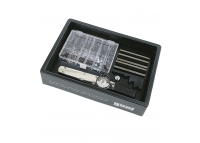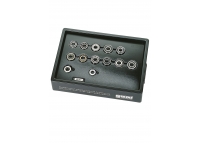Fasteners and machine parts
Components of a technical application that fulfil certain functions in structures are known as machine elements. Machine elements can be both single components and assemblies.
Simple machine elements such as screws, cylinder pins, feather keys or seals are defined according to standards and therefore can be exchanged without difficulty. More complex machine elements such as bearings, couplings, gears or shafts are standardised in only certain important properties, such as main dimensions or flanges, and as such are not fully interchangeable.

Familiarisation with various pin types, their special features and applications
Learning objectives/experiments
- familiarisation with different types of pin and their specific applications: grooved pins, dowel pins, straight pins, tapered pins
- familiarisation with the relevant standard designations and terms, including graphical representation
- planning and execution of all steps in the workshop environment
- familiarisation with types of pinned joint
- working with fits and tolerances

Familiarisation with various feather keys, their production, special features and applications
Learning objectives/experiments
- production of different feather keys: round ended and straight ended
- assembly of feather key joints: light fit/sliding fit
- familiarisation with the relevant standard designations and terms, including graphical representation
- planning and execution of all steps in the workshop environment
- familiarisation with types of keyed joint
….

Familiarisation with various taper keys, their production, special features and areas of application
Learning objectives/experiments
- production of different taper keys: round ended, straight ended, nose key, tangential key pair, cotter
- assembling taper key joints:
- familiarisation with the relevant standard designations and terms, including graphical representation
- planning and execution of all steps in the workshop environment
- familiarisation with types of taper-keyed joint
….

Practical workshop exercises on the topic of threaded fasteners, tightening and breakaway torques
Learning objectives/experiments
- tightening a threaded joint to a preset torque
- measuring the breakaway torque as a function of the bolt length, property class, bolt locking type and tightening torque
- familiarisation with the relevant standard designations and terms, including graphical representation

Comprehensive instructional kit of the main nuts and bolts used in engineering
Learning objectives/experiments
- familiarisation with the most important screws and nuts used in mechanical engineering and their specific applications
- familiarisation with relevant standardised designations and terms including their graphical representations

Standardised designations, terms and graphical representation of different screw-locking devices
Learning objectives/experiments
- familiarisation with screw-locking devices and their specific applications
- familiarisation with relevant standardised designations and terms including the graphical representation

Standardised designations, terms and specific applications of different thread types, determination of the thread type with the thread gauge
Learning objectives/experiments
- familiarisation with the most important thread types used in mechanical engineering and their specific applications
- use the thread gauge to determine the thread type

Familiarisation with the most important roller bearing types and their specific applications
Learning objectives/experiments
- familiarisation with the most important roller bearing types used in mechanical engineering and their specific applications
- familiarisation with relevant standardised designations and terms
- discussion of applications

Mode of operation and layout of a spur gear
Learning objectives/experiments
- development of the main variables and relationships in a straight-toothed spur gear
- velocity ratios in spur gears
- gear with intermediate wheel or two-stage gear
- influence of gear ratio on friction
- determine the efficiency

Demonstration and measurement of the displacement curves for cam mechanisms
Learning objectives/experiments
- elevation curves in cam mechanisms
- cams come in different shapes
- circular arc, tangent, hollow, asymmetric
- optionally with roller plunger, flat plunger or cam follower as engaging member

Mode of operation and layout of a worm gear
Learning objectives/experiments
- development of the main variables and relationships in a worm gear
- investigation of transmission ratio, torque, friction and self-locking
- determine the efficiency

Correlation between tightening torque and tension force on standardised bolts
Learning objectives/experiments
- axial tension force in a bolt joint dependent on the tightening torque or the elastic deformation of a slotted block
- measurement of the breakaway torque, including for different fitting situations of the bolt joint
- measurement of thread friction and overall friction

Sliding bearing friction with different bearing material pairings and comparison with rolling bearing friction
Learning objectives/experiments
- determine the frictional moment in slide bearings with various friction pairs
- determine the frictional moment of a rolling bearing
- comparison of slide and rolling bearings
- basic experiments on rotational dynamics

Learning the fundamentals of hydrodynamic lubrication by experimentation
Learning objectives/experiments
- develop an understanding of technological relationships of hydrodynamic lubrication by experimentation
- frictional moment in a journal bearing as a function of
- speed
- bearing load
- lubricant and lubricant temperature


